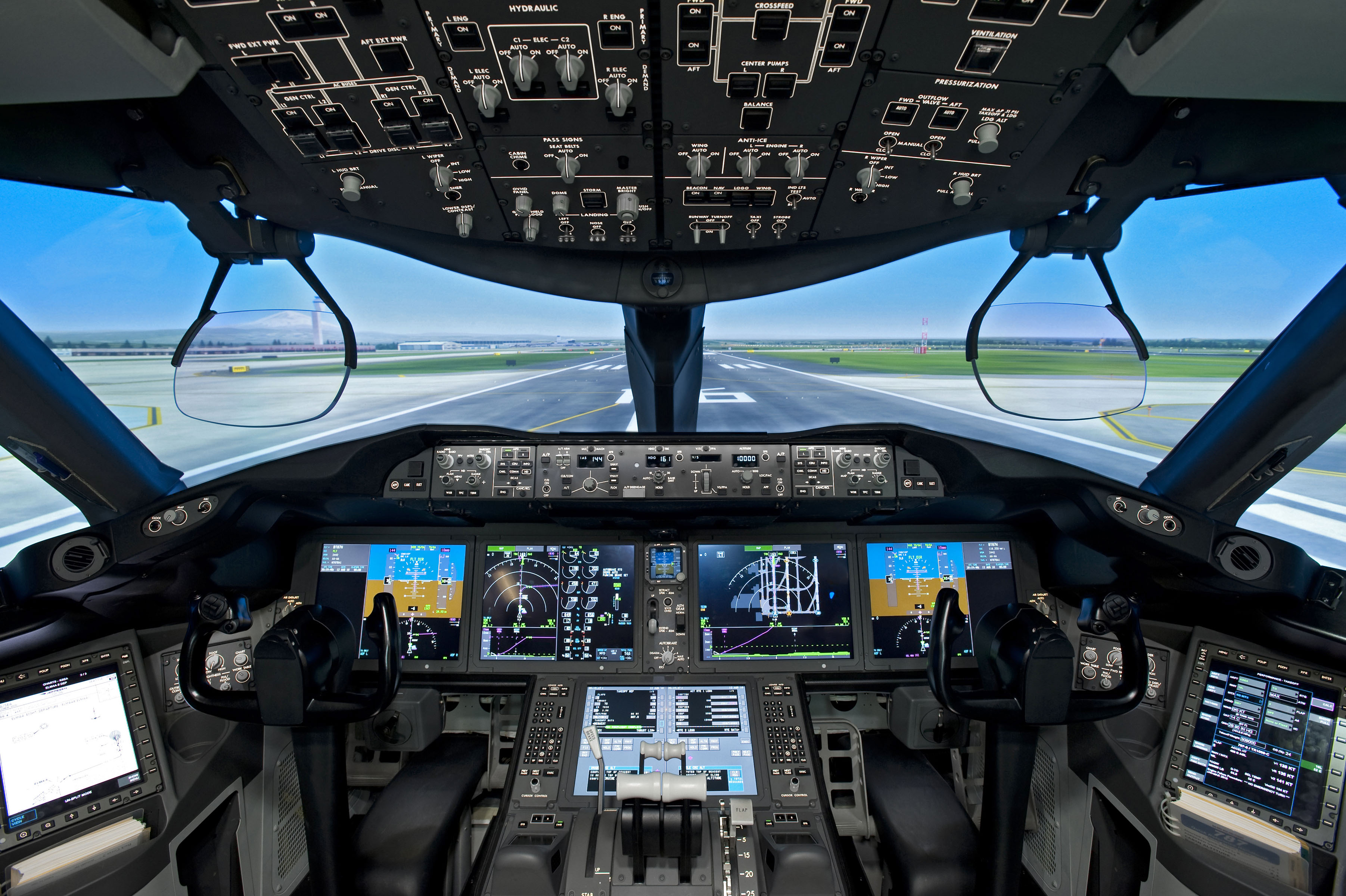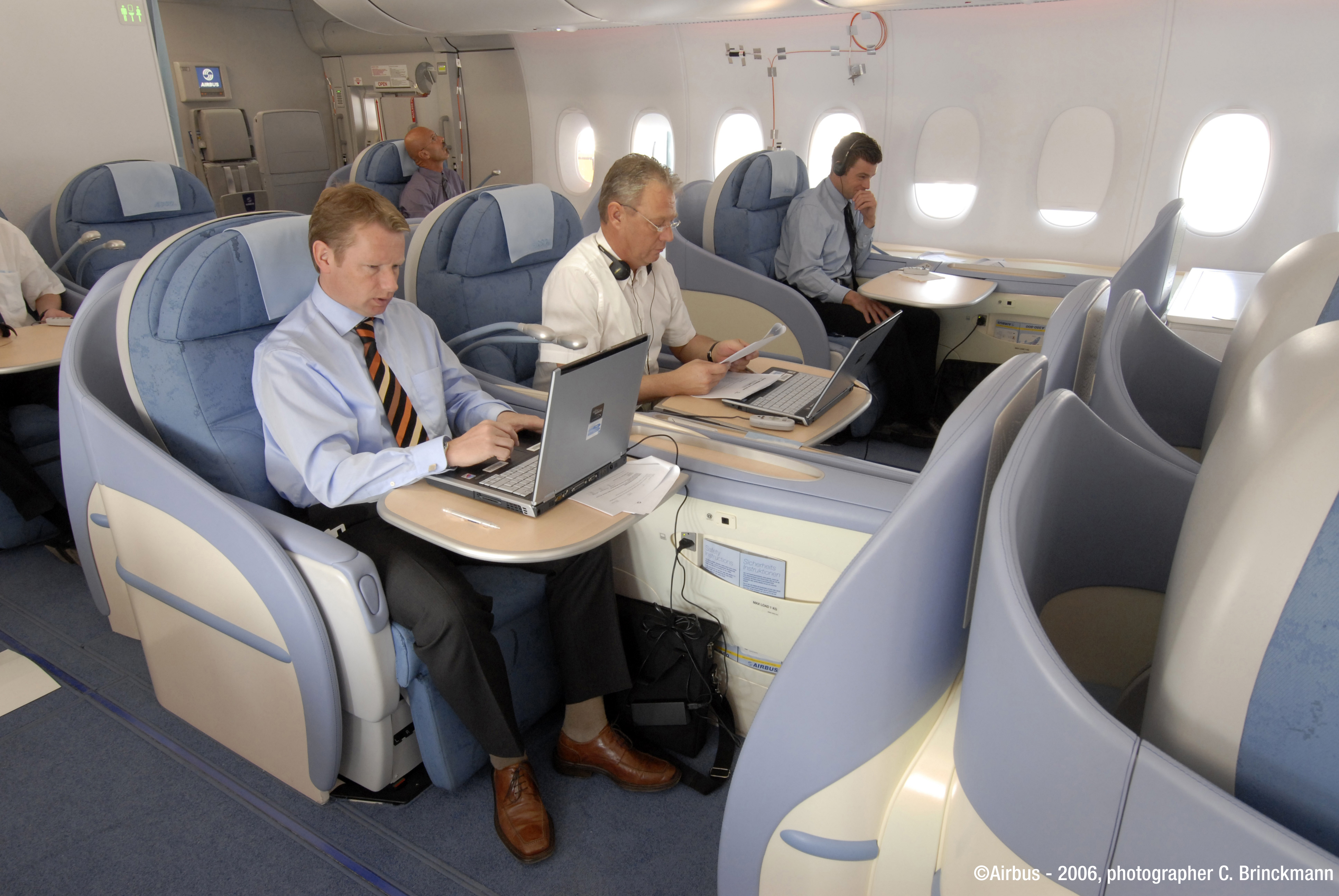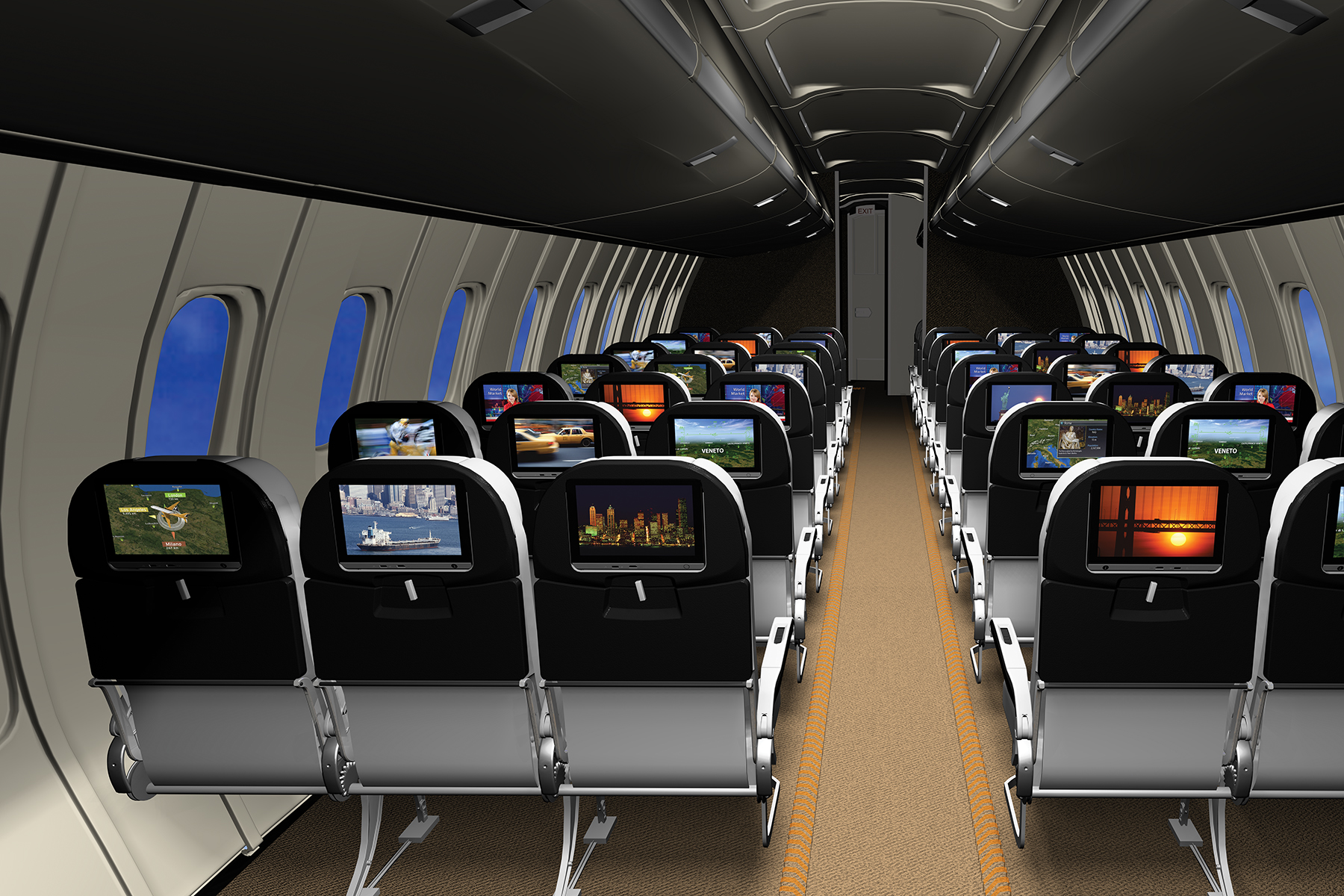Articles
| Name | Author |
|---|
A digital aircraft future
Author: Mario Sabourin, Sr. Product Manager, EFB, SITA
Subscribe
With the latest aircraft IT capabilities, Mario Sabourin, Sr. Product Manager, EFB at SITA explains that users must do more than simply plug them in to the existing system.

A380 Cabin Test
Tackling areas of inefficiency in aircraft operations
In terms of efficiency, aircraft operations have always been hindered by complex and intertwined processes, involving many stakeholders. This is further compounded by multiple incomplete data sources as well as limitations on the availability of the type and timeliness of such information. Three particular burdens stand out:
- Manual and labour-intensive processes. Typical aircraft operational processes and procedures comprise hundreds of individual tasks, inputs and outputs. They necessitate the involvement of dozens of different personnel roles across multiple functional organizations within the airline. Reducing the sheer labour intensity of these procedures – while improving the quality of information – would shorten process times and avoid the potentially large cost of delays.
- Paper-based environment. Typically, an extensive library of paper-based content exists on-board each and every aircraft. It includes navigational charts, approach and departure ‘plates’, aircraft take-off and landing performance tables, internal company documentation, and manuals from the aircraft manufacturer and other suppliers. That’s not to mention the dozens of pages of flight specific information that pilots themselves bring into the cockpit prior to each departure. All of this material has to be regularly updated and the revision process itself must be documented and controlled. This means printing, copying, collating and distributing updates whenever existing content changes or new content is added. Not only is this a laborious exercise but one fraught with the potential for human error or omission.
- Data access, availability and latency. As a largely manual approach, post-flight data gathering – to track and monitor aircraft reliability and other types of performance – is also time-consuming, with significant delays and loss or corruption of data. Similarly, line maintenance is still a mostly manual affair, in terms of information flow and process management. These activities generally involve communicating aircraft defects, and deferring action on them while the required documents are referenced, before finally taking corrective action.
Aircraft communications – until now, one of the major constraints to automation
In addition to mandated voice communications, most commercial aircraft today are equipped with avionics that use the aircraft communications addressing and reporting system (ACARS) for data communications. First deployed in 1978, ACARS allows aircraft to exchange blocks of text-based messages with ground based systems. This has been instrumental in reducing the limitations of and dependency on the use of voice radio by pilots. Since its introduction, ACARS has evolved from being a means to report simple aircraft movements to an indispensable tool on which several important airline and air traffic control processes now depend. However, as demand drives the volume and complexity of data communications, ACARS is itself being pushed to its very limits.
But what if? Potential scenarios with new generation aircraft
Now imagine the possibilities of an environment where aircraft can handle near real-time exchange of gigabytes of information – in effect becoming flying data centres. What possibilities might that offer for airlines and passengers alike?
Consider some potential scenarios
- Pilots can overlay live weather images on their 3D navigation displays that show other aircraft in the immediate airspace. With a keystroke, they can obtain real-time status on rapidly changing conditions – such as airspace congestion, airport closures or even volcanic activity. The pilots can adjust flight plans accordingly, while their aircraft automatically exchanges critical parameters with air traffic controllers’ and dispatchers’ ground systems and even other aircraft in the vicinity.
- Flight dispatchers can obtain complete, timely information on flight and aircraft parameters. It is automatically fed into their systems to optimize flight plans and operations across the entire network, leaving the dispatchers free to focus on preventing and managing operational disruptions.
- Air traffic controllers can automatically receive actual and ’intention’ parameters from aircraft in their own and adjacent airspaces. They use this data to optimize airspace utilization and to alert controllers of potential conflicts well before they happen.
- Maintenance teams can receive reports of failures and warnings as they happen, as well as entire files of relevant flight, engine and aircraft parameters that are streamed throughout the flight. It gives them the ability to initiate diagnostic and remedial action while the aircraft is still in the air, en route to its next destination.
- Engineering can remotely schedule the wireless loading and activation of avionics software, overcoming the need to remove and refit any hardware on-board the aircraft.
- Regulators and civil authorities can obtain up-to-the-minute information from logs and aircraft systems’ data for any given flight. It enables them to conduct compliance audits and carry out incident investigations at a moment’s notice and with greater precision.
- Commercial departments can obtain the latest operational information to update customers about potential flight disruptions. At the same time, marketers can leverage the communication capabilities of aircraft to generate ancillary revenues and differentiate their offerings with in-flight passenger communications and entertainment services.
- Passengers can enjoy continued use of their own communications devices and the same standard and scope of media services in the air that they would on the ground. More than that, they can directly receive additional information about any changes to their personal itineraries as events arise, via their mobile devices or in-seat displays.
Some of these scenarios are already becoming reality in various, albeit limited, forms. But they are still in their infancy and currently lack the seamlessness and breadth of communications capabilities to truly transform the various aspects of aircraft operations and on-board customer services.
Enter IT-enabled aircraft – the game changers
 The drive for novel and better ways to operate aircraft is nothing new. What is new is the tools enabled by IT that allow operators to radically change processes and procedures. Systems such as in-flight entertainment and electronic flight bags (EFBs), as well as applications and tools like e-logbooks and loadable software aircraft parts (LSAPs), are but a few examples of new on-board IT components facilitated by IP (Internet protocol). And examples of the impact stem from airplane health and cabin management, and accessibility of charts and manuals. The development of the digital aircraft, complete with systems and wireless capabilities based on IP, plus the powerful applications that use them, has been spearheaded by Airbus and Boeing with the launch of the A380, together with new variants of the 777, and the upcoming 787 and A350. These aircraft and their IP-capable avionics can communicate both within the aircraft and externally at rates several hundred times faster than those achievable over ACARS.
The drive for novel and better ways to operate aircraft is nothing new. What is new is the tools enabled by IT that allow operators to radically change processes and procedures. Systems such as in-flight entertainment and electronic flight bags (EFBs), as well as applications and tools like e-logbooks and loadable software aircraft parts (LSAPs), are but a few examples of new on-board IT components facilitated by IP (Internet protocol). And examples of the impact stem from airplane health and cabin management, and accessibility of charts and manuals. The development of the digital aircraft, complete with systems and wireless capabilities based on IP, plus the powerful applications that use them, has been spearheaded by Airbus and Boeing with the launch of the A380, together with new variants of the 777, and the upcoming 787 and A350. These aircraft and their IP-capable avionics can communicate both within the aircraft and externally at rates several hundred times faster than those achievable over ACARS.
In addition, many existing aircraft can be retrofitted with these or similar avionics, unlocking some of the potential to implement substantial operational improvements across entire fleets.
It’s no exaggeration that the combined availability of broadband connectivity to the aircraft – on the ground and in flight – offers immense potential for a completely new generation of aircraft operations. This will be in both scope and magnitude, including:
- The provision of complete, real-time information from any system on board the aircraft to anyone authorized to receive it.
- The availability of the latest information between ground systems and flight crews in formats that best suit its interpretation.
- New options for on-board passenger services.
The way forward – acting today to prepare for tomorrow
Although the air transport industry will likely develop the necessary aircraft standards over the coming years to facilitate the on-board adoption and integration of IP technologies, it is less clear how airline IT departments can prepare for the arrival of digital aircraft. What considerations or measures can be taken in the near term? What can airline IT decision makers do now to ensure they’re ready to fully embrace digital aircraft into their fleet when the time comes, rather than holding their collective breath for emerging standards and approaches to be agreed?
Near-term actions for forward-thinking IT departments: anticipate which business processes will need to be re-aligned or re-engineered
To understand the operational enhancements, cost savings and revenue opportunities that are realistically achievable, it is helpful to first identify an airline’s typical current (or ‘as is’) processes which will correspond directly to setting measurable targets for the implementation of IT-enabled (or ‘to be’) processes. An assessment of process re-engineering options is also vital before attempting full migration to a paperless environment or digital tools such as EFBs. Crucially, interdepartmental collaboration must be encouraged throughout – as previously noted – because connectivity has the potential to affect a much broader range of stakeholders and functional contributors than might be initially conceived.
Prepare for the introduction of new applications. The number of applications developed to capitalize on IP connectivity will proliferate over time. Key issues to consider now are how the airline intends to manage their introduction and how you will integrate them with ground systems.
Manage the introduction of Electronic Flight Bags. Ensure the chosen EFB solution is secure, well integrated with airline systems and makes best use of both the airborne and ground based communication infrastructure. To capitalize on the potential efficiency gains of an IT-enabled aircraft, it is essential to reduce the variances in operational procedures across fleets due to different EFB classes and implementations. As with any significant innovation in IT, the deployment of EFBs brings the need to develop robust operational and security policies to mitigate exposure to unprecedented risks.
Consider aircraft connectivity and security requirements. Assess the current connectivity strategy and its readiness for the IT-enabled aircraft as another ’node of the network’. Then re-appraise it to account for both cockpit and cabin requirements. Determine the key attributes to ensure the appropriate level of security. In general, establishing a safe environment for the aircraft to communicate will demand the introduction of security policies consistent with those required by a ground based virtual private network (VPN) wireless environment.
Furthermore, take account of which type of connectivity is best suited to which activity, frequency of data exchange, time sensitivity and the need for cut over to deliver seamless availability. For example, is the intention to update in-flight entertainment content when the aircraft is parked at the gate or when it arrives at its destination, where connectivity and security considerations may be very different?
Prepare your ground systems. Connecting the aircraft environment to the back office is critical. And as the number of EFB devices across your fleet grows, and applications become more sophisticated, there will be the need to manage increased complexity across an integrated communications network. As more information is delivered to a broader range of ground systems, the need for tight version control will become ever greater.
Optimize aircraft turnaround processes by mobilizing your workforce. By equipping ground staff with handheld devices, it’s possible to reduce latency between decisions and actions, provide real-time resource management and ‘data in the palm’ insight with IP. For example; a last minute gate change need no longer result in a delayed departure: with the tap of a touch-screen, ground workers can acknowledge the re-assignment and their task schedule is automatically updated. They can then proceed directly to the new gate, resulting in a prompt turnaround and on-time departure.
Start building the value case. Assess ancillary revenue opportunities from expanding passenger services, or the value of new functionality in enhancing the customer experience and offering valuable points of differentiation for the airline.
Engage in collaborative industry activities. Take part in industry activities to better understand dependencies on standards and local infrastructures. It’s vital to consult and co-ordinate with industry representatives who are trialling initiatives in this domain to benefit from their hard-won learning. Similarly, open dialogue with alliance partners who, for example, can offer valuable shortcuts to success rather than re-inventing the wheel, as well as greater opportunities for harmonization in what will ultimately be an industrial, rather than individual, effort. See under ‘Key industry initiatives, vital sources of support’.
The way forward – acting today to prepare for tomorrow: ‘get real’
Successful incubation of the digital concept cannot be synthesized in the laboratory. Carefully managed and monitored ‘in vivo’ implementations will provide a realistic picture of the success or otherwise of initiatives and can be fine-tuned to create viable, long-term solutions.
A call for collaboration
With the widespread introduction of IT, the industry faces the risk of fragmentation, where each stakeholder in the value chain will have their own way of providing connectivity and services. Each will have to manage hundreds of technology and service combinations. The diversity runs from aircraft types and aircraft avionic systems to network operators and technologies, and embraces airports and airport IT services, as well as airline ground systems. It requires no stretch of the imagination to envisage that this complexity – and the high costs of entry – could lead to slow deployment and ramp-up: in short:
- Airframe manufacturers face key issues revolving around complex IT and communications with rapid obsolescence, as well as long avionics fitting and retrofitting cycles.
- Airports face a situation where standards or best practice guides are currently being developed to ensure that airlines will experience homogeneous services at airports around the world. But that process is in its early stages and they currently cover only high-level aspects, so apart from major hubs, airlines (individually or collectively) can generally find it challenging to convince airport operators to deploy wireless coverage.
- Airlines face the issue of disparate IT solutions from the avionics suppliers and airframer for a mixed fleet, as well as the likelihood that each airport provider requires different network interfaces.
To realize the vision
In short, to realize the digital aircraft vision on a truly globalized basis, the air transport industry needs to resolve two key issues:
- How to work together to ensure standardization and a consistent approach in terms of what form the global infrastructure should take.
- How to facilitate the deployment of global infrastructure.
Don’t neglect the human factors
While the potential benefits of digital aircraft are undeniable, it pays to be mindful of some of the broader social repercussions that could arise as a result of an intense period of technological change:
- Labour relations change management. Automation implies by default a change to the existing dimensions of job role. Typically, employees may be asked to do more, or scale the learning curve of new working practices, or master the use of new tools. This could potentially pose challenges of adaptation or acceptance, whether in skillset or approach, leading to an initial drop in productivity.
- Greater reliance on automation in aircraft and flight operations. Not all operatives, agents or crew members may be comfortable working in a connected environment, where there is greater reliance on ‘invisible’ systems as opposed to the tangible if less efficient qualities of analogue, paper-based methodologies.
- Cockpit resource management. Issues may arise as a result of cramming more technology into the cockpit – a significant issue that could compromise safety. Risks could include loss of situational awareness in a data-only ‘silent’ cockpit in the absence of radio contact; longer ’heads down’ time or increased possibility of distraction due to information overload; failing to deliver the right information to the right person; or causing pilots to use alternative means (for example, personal mobile phones) to access useful flight information not available through standard cockpit systems, such as latest weather information. The need for rigorous training as part of the change management process is a must.
- Acceptance of in-flight mobile use. Early signs from live services to date are encouraging in that passengers are not finding voice calls made on board unacceptably intrusive. With the availability of mobile data and satellite broadband, there is in fact a tendency for business travellers in particular to use their mobile devices preferentially for email or other data communications rather than voice calls, especially among smartphone users.
Comments (0)
There are currently no comments about this article.

To post a comment, please login or subscribe.